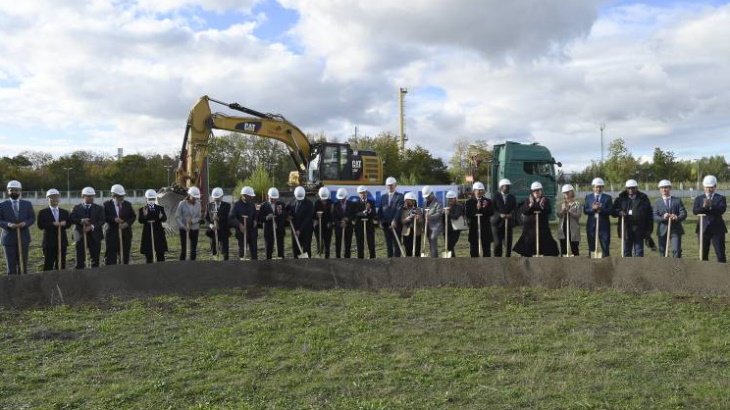IAEA breaks ground on new laboratory block
The International Atomic Energy Agency (IAEA) has held a groundbreaking ceremony at its Seibersdorf facility near Vienna to mark the start of construction on a new nuclear applications laboratories building. The new building will house three laboratories: Plant Breeding and Genetics (PBGL), Terrestrial Environment and Radiochemistry (TERC) and Nuclear Science and Instrumentation (NSIL).

The groundbreaking ceremony at Seibersdorf (Image Dean Calma / IAEA)
Recent donations from Belgium, Saudi Arabia and the USA together with strong member state financial support allowed the IAEA to sign a contract on 29 September to begin construction on the new laboratories building.
The three new laboratories will help countries address challenges related to climate change, food security, environmental management and more. Major construction on the new building is expected to be completed by the end of 2024.
As part of ReNuAL2, the IAEA also plans to build new greenhouses - necessary for its work in plant breeding, food safety, soil and water management and crop nutrition - adjoined to the new laboratories building. Resource mobilisation efforts will now focus on obtaining the funding needed for this last element of the ReNuAL2 initiative.
"After two years of hard preparation, we now begin construction to complete the modernisation of our invaluable Seibersdorf labs - laboratories that make important contributions in the global fights against disease, climate change and world hunger," said IAEA Director General Rafael Mariano Grossi at the groundbreaking ceremony on 3 October. The event was attended by representatives from 30 IAEA Member States, and host government representatives from the federal level, Regional Government of Lower Austria and Seibersdorf Town.
"As a year, 2020 was a wake-up call on human vulnerability to disease, climate disaster, food insecurity and environmental degradation," Grossi said. "The pledges to this project by our member states are helping to ensure our labs remain modern and can continue to play a vital role in addressing these pressing challenges."
The IAEA Seibersdorf facility, which opened in 1962, houses eight nuclear applications laboratories working in food and agriculture, human health, environmental monitoring and assessment, as well as two safeguards analytical laboratories for nuclear verification.
The IAEA and its member states launched in 2014 an initiative to modernise the laboratories to maintain their capacities to respond effectively to these demands in years to come. Known as the Renovation of the Nuclear Applications Laboratories (ReNuAL), the initiative is now well advanced. In June 2019, the Dosimetry Laboratory opened its new Linear Accelerator Facility. In October 2019, the Insect Pest Control Laboratory moved into a modern new laboratory building. The new Yukiya Amano Laboratories building opened for operations in June 2020 and now houses the Animal Production and Health Laboratory, the Soil and Water Management and Crop Nutrition Laboratory (SWMCNL), and the Food and Environmental Protection Laboratory.
Recognising the importance of all the laboratories in helping member states address a range of existing and emerging development challenges, in September 2020 Grossi announced his intention to complete the modernisation of the Seibersdorf laboratories. The final phase of the modernisation initiative, called ReNuAL2, to construct a new building - provisionally called the Flexible Modular Laboratory 2 - to house the three laboratories that had not yet been modernised in ReNuAL's earlier phase, refurbishing the Dosimetry Laboratory, and replacing the aged greenhouses used by the PBGL, SWMCNL and Food Safety and Control Laboratory.
To date, ReNuAL2 has raised more than EUR20 million (USD20 million) from 28 countries.
Researched and written by World Nuclear News
- China Institute of Atomic Energy
- Nuclear Power Institute of China
- Southwestern Institute of Physics
- China Nuclear Power Operation Technology Corporation, Ltd.
- China Nuclear Power Engineering Co., Ltd.
- China Institute for Radiation Protection
- Beijing Research Institute of Uranium Geology (BRIUG)
- China Institute of Nuclear Industry Strategy (CINIS)
- China Nuclear Mining Science and Technology Corporation


